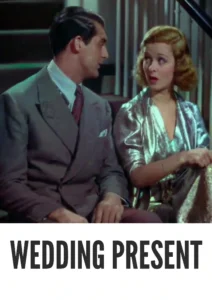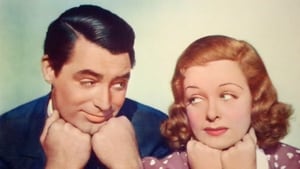Contact: info@alwanfilm.com
Video Sources 0 Views
- Wedding Present


Synopsis
Table of Contents
ToggleReview: Wedding Present 1936 Colorized – A Heartwarming Romantic Comedy in Vivid Color

Introduction
“Wedding Present” (1936) is a delightful romantic comedy that has stood the test of time, captivating audiences with its charming characters and witty dialogue. In this article, we’ll explore the significance of this early colored film and its enduring appeal in the realm of romantic cinema.
Check The Full Colorized Movies List
Check Our Colorized Movies Trailer Channel
Understanding Wedding Present 1936 Colorized: Director, Cast, and Genre
Directed by the talented Richard Wallace, “Wedding Present” (1936) showcases his skill in crafting lighthearted comedies that resonate with audiences. The film features a stellar cast, including Cary Grant and Joan Bennett, whose on-screen chemistry sparkles with charm and charisma. Blending elements of romance, comedy, and drama, “Wedding Present” (1936) transports viewers to a world where love conquers all and laughter is the best medicine.
Exploring the World of Wedding Present 1936 Colorized: Plot and Characters
At its heart, “Wedding Present” (1936) follows the misadventures of two newspaper reporters, played by Cary Grant and Joan Bennett, whose professional rivalry turns into a whirlwind romance. As they navigate the ups and downs of their tumultuous relationship, they discover the true meaning of love and commitment in the most unexpected of places. Along the way, they encounter a colorful cast of characters who add humor and heart to their journey, making “Wedding Present” (1936) a joyous celebration of the human spirit.
The Art of Film Colorization
Film colorization serves as a transformative tool that enhances the visual experience of classic movies, allowing viewers to immerse themselves in the rich tapestry of cinematic worlds. By digitally adding color to black and white films, colorization breathes new life into timeless stories, inviting audiences to rediscover their favorite films in vivid detail.
Early Colored Films: A Brief History
The history of colored films traces its roots back to the early days of cinema, with filmmakers experimenting with various techniques to add color to their creations. From hand-tinted frames to early Technicolor processes, the evolution of colored film has been marked by innovation and ingenuity, paving the way for the development of modern colorization techniques that continue to captivate audiences to this day.
Wedding Present 1936 and Its Early Colored Version
The decision to release “Wedding Present” (1936) in a colorized format was met with both anticipation and excitement. While some purists may have had reservations about tampering with the film’s original aesthetic, others welcomed the opportunity to experience the classic romantic comedy in vibrant color. Ultimately, the early colored version of “Wedding Present” (1936) offers viewers a fresh perspective on the timeless tale of love and laughter, enhancing its charm and appeal for modern audiences.
The Debate Over Film Colorization
The debate over film colorization is a contentious issue, with passionate arguments on both sides of the divide. Proponents argue that colorization revitalizes classic movies for modern audiences, breathing new life into timeless stories and introducing them to a new generation of viewers. Detractors, however, maintain that colorization compromises the artistic integrity of the original work and diminishes its historical significance. As the debate rages on, filmmakers and audiences alike are left to ponder the merits and drawbacks of colorization in the ever-evolving landscape of cinema.
Examining Wedding Present 1936 as an Early Colored Film
As with any colorized classic, the impact of colorization on “Wedding Present” (1936) is a matter of personal interpretation. Some may argue that it enhances the film’s visual appeal and immerses viewers in its world, while others may feel that it detracts from the simplicity and elegance of the original black and white version. Regardless of one’s stance on the issue, there’s no denying the enduring charm of “Wedding Present” (1936) as a timeless romantic comedy that continues to warm the hearts of audiences around the world.
Influence and Legacy: Wedding Present 1936’s Impact on Cinema
“Wedding Present” (1936) has left an indelible mark on the world of cinema, inspiring countless filmmakers and captivating audiences with its timeless tale of love and laughter. From its memorable performances to its witty dialogue, the film continues to resonate with viewers of all ages, reaffirming its status as a beloved classic of the romantic comedy genre.
Director’s Cinematic Legacy: Beyond Wedding Present 1936 Colorized
Richard Wallace’s influence extends far beyond “Wedding Present” (1936), with a diverse body of work that continues to captivate audiences around the globe. From “The Fallen Sparrow” to “The Little Minister,” Wallace’s films are celebrated for their wit, charm, and sophistication, solidifying his legacy as one of the preeminent directors of Hollywood’s Golden Age. Through his groundbreaking work, Wallace has left an indelible imprint on the world of cinema, inspiring generations of filmmakers to follow in his footsteps.
Themes Explored in Wedding Present 1936 Colorized
“Wedding Present” (1936) explores a myriad of themes, from the transformative power of love to the importance of friendship and loyalty. Through its richly drawn characters and witty storytelling, the film invites viewers to ponder the complexities of human relationships and the enduring strength of the human spirit. As audiences immerse themselves in the world of “Wedding Present” (1936), they are reminded of the universal truths that bind us together and the timeless appeal of love in all its forms.
Reception and Controversy Surrounding Wedding Present 1936 Colorized
Upon its release, “Wedding Present” (1936) received widespread critical acclaim, with many praising its charming performances, witty dialogue, and timeless humor. However, the decision to release the film in a colorized format sparked debate among purists, reigniting the age-old discussion surrounding film preservation and artistic integrity. Despite the controversy, “Wedding Present” (1936) remains a beloved classic that continues to resonate with audiences of all ages, reaffirming its status as a timeless masterpiece of the romantic comedy genre.
Where to Watch Wedding Present 1936 Colorized Online
For those eager to experience the timeless charm of “Wedding Present” (1936), the film is readily available on popular streaming platforms such as Netflix, Amazon Prime, and Hulu. Whether you choose to watch it in its original black and white format or the early colored version, “Wedding Present” (1936) promises to transport you to a world of love and laughter, where romance blooms and happiness reigns supreme.
FAQs About Wedding Present 1936 Colorized
Q: Is “Wedding Present” (1936) based on a true story? A: No, “Wedding Present” (1936) is a fictional tale crafted by screenwriters Joseph Anthony and Frank Vosper, who drew inspiration from their own experiences and observations of human relationships.
Q: Who are the main actors in “Wedding Present” (1936)? A: “Wedding Present” (1936) features an ensemble cast led by the charismatic Cary Grant and the enchanting Joan Bennett, whose on-screen chemistry lights up the screen with laughter and romance.
Q: What awards did “Wedding Present” (1936) win? A: While “Wedding Present” (1936) did not win any major awards, it received critical acclaim for its charming performances, witty dialogue, and timeless humor.
Q: Why was “Wedding Present” (1936) released in a colorized format? A: The decision to release “Wedding Present” (1936) in color was made to introduce the film to a new generation of viewers and enhance its visual appeal for modern audiences. While the choice to colorize the film sparked debate among purists, it ultimately allowed “Wedding Present” (1936) to reach a wider audience and ensure its continued relevance in the annals of cinematic history.
Conclusion
As we bid farewell to the delightful world of “Wedding Present” (1936), let us celebrate its enduring legacy as a timeless romantic comedy that continues to warm the hearts of audiences around the world. Whether viewed in its original black and white format or the early colored version, “Wedding Present” (1936) remains a shining example of the power of cinema to inspire, entertain, and uplift the human spirit.
So, whether you’re a hopeless romantic or a casual moviegoer, take a moment to revisit “Wedding Present” (1936) and experience the magic of love and laughter as only classic Hollywood can deliver. For in the timeless tale of romance and comedy that unfolds on screen, you’ll find a treasure trove of joy and wonder that will stay with you long after the credits roll.











